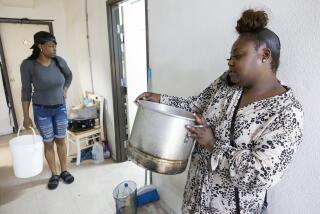Eviction Looms for Poor Families : Santa Paula: The county says the converted apartments are unsafe. Some of the farm workers plan to live in cars.
Six poor Latino families living in a clapboard apartment house outside Santa Paula say they will be forced onto the street Monday because county building inspectors have declared the building unsafe.
Eviction notices were posted last month, surprising the 28 people who live in the converted motel on Telegraph Avenue near California 126.
The farm-worker families, many of whom have lived in the ramshackle apartments for years, said they will move into their cars or onto the street because they cannot find affordable housing.
“It’s a catastrophe,” said neighbor Vincente Razo, 62, as he watched tenant Mary Jones move her belongings out of a $325-a-month room and into a relative’s van. “They won’t be able to find anything in town with a comparable rent.”
Thirty-day eviction notices were issued after inspectors, acting on a complaint from a neighboring rancher, discovered dangerous electrical wiring and substandard plumbing in the apartments. The county granted a two-week extension Aug. 12 after families said they had no place to move.
“I gave them a little extra time out of the kindness of my heart, but next week they will leave,” code enforcement officer Jim Van Voorhis said. “I don’t know where they will go from there, but those apartments aren’t safe.”
Several tenants questioned why the county is pushing them out so swiftly after letting them live in the 65-year-old apartments for years.
Anna Garcia, who has lived with her husband and three children in their one-room apartment for 14 years, said she was caught off guard.
“I’m on two waiting lists,” Garcia said, “but they don’t have anything right away.”
Abdulia Arambula said she has located a house in Ojai, but it won’t be available to her family for several months. She said the evictions seemed rushed.
On a wall outside the apartments, the county has posted a Day-Glo red sign warning tenants that their power will be disconnected the first of the week-- without exception. If need be, one official said, sheriff’s deputies will be called to remove the tenants.
A spokeswoman for the Ventura County Housing Authority said the county Building and Safety Department made no attempt to coordinate the eviction with the availability of housing, although similar arrangements have been made between the two agencies in the past.
“I am not aware of any contact,” said Carolyn G. Briggs, executive director of the housing authority.
Briggs said the families’ wait for subsidized housing could exceed a year, since the housing authority is only now placing families who applied in 1990.
And while the tenants cope with certain eviction, the apartments will probably remain vacant because the owners say they cannot afford to demolish them.
John Davalos, a San Jose area resident, said he has tried to provide “a quality life for the people” since he took control of the apartments after his father’s death 10 years ago. He and his 88-year-old mother, Alice Davalos, who lives next to the property, own the building.
Davalos said that despite income of $1,950 a month from the apartments, he could not afford to repair them. Tenants said Davalos has raised their monthly rent by $100 since 1988.
County building official William Windroth said illegal living conditions were first discovered at the apartments in 1989. But a series of stern warnings did not persuade Davalos to bring his building up to county code. Inspectors never cited the owners for the conditions.
“It slipped through the cracks,” Windroth said.
Under state law, local governments can take control of slum properties and direct repairs if the owner fails to fix them up, according to the district attorney’s office.
At the old motel, which was converted into apartments for farm workers in the 1950s, the rooms have worn linoleum floors, chipped plywood walls and dangling electric wires.
“It’s been Mickey-Moused around for a long time,” Windroth said. “The apartments are literally falling down.”
Windroth said the possibility of a fire or an electrocution in the apartments has forced him to evict the tenants. He said inspectors provided the families with a list of agencies that might be able to help them find other rooms. But Windroth said he did not contact any of the agencies.
Cabrillo Economic Development Corp. expects to break ground next month on a 150-unit, low-income project in Santa Paula, company official Jesse Ornelas said. But the project is for senior citizens only, he said.
Ornelas said protests inevitably arise in Ventura County communities whenever a low-cost project is proposed.
Just this week, 250 Oxnard residents showed up at a City Council hearing to protest the relocation of a family homeless shelter to their neighborhood.
“We definitely need more housing for low-income families,” said Briggs, the housing authority official.
Only about 2,000 dwellings for poor people were built in the 1980s, officials say.
Despite the conditions on Telegraph Avenue, tenant Yesenia Bautista said she is satisfied with her living arrangement “because it’s cheap and I like my neighbors.”
Her landlord, Alice Davalos, “is kind of like a grandmother to us,” said the 18-year-old Bautista. “I’m sure it will be hard for her to say goodby too.”
More to Read
Sign up for Essential California
The most important California stories and recommendations in your inbox every morning.
You may occasionally receive promotional content from the Los Angeles Times.










